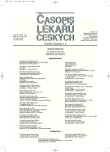Child abuse in common family population – a longitudinal study
Authors:
L. Kukla; M. Bouchalová
Authors place of work:
Výzkumné pracoviště preventivní a sociální pediatrie LF MU, Brno
Published in the journal:
Čas. Lék. čes. 2009; 148: 254-263
Category:
Původní práce
Summary
Background.
Dunovský, Dytrych, Matějček et al. have published their experience from their consulting and interventional activities, alongside with an analysis of the paediatric, psychological, psychiatric and social components of the child’s development in the family and outside it, in a fundamental and still up-to-date paper (1, 2). In this elaborate they emphasized the necessity to map the occurrence, in our country, of pathological phenomena included in the CAN notion – a child that is abused and neglected. The background of the presented study lays in a retrospective investigation in an adult population. The subject of the study are men – the near future fathers of the investigated children, who have among other information specified within an extensive personal history if and how they were maltreated in their childhood.
The goal of the study:
A group of men maltreated in childhood is compared to a group which was not maltreated and the investigating team searched for indications as to how different were their natal families, their parents and their own selves and if any identifiable differences occurred later in their own families, relationships, conduct and health.
Methods.
A comparative study was conducted in the group of fathers based on three consecutive questionnaire investigations, between those maltreated in childhood and those who were not maltreated (control). Fathers maltreated in childhood were identified based on the response variants (1 – often, 2 – sometimes, 3 – never) to three questionnaire inquiries filled in before the birth of their children who are included in the ELSPAC (European Longitudinal Study of Pregnancy and Childhood) study. The data was provided by men whose wives with permanent residence in Brno gave birth from March 1st 1991 till June 30th 1992.
Results.
According to three types of test it was found out that from the parents of the studied children 57.9 % of the 3580 fathers and 48.3 % of the 3848 mothers were physically or psychologically maltreated during childhood: boys were maltreated more often.
Maltreated fathers as compared to control:
a) were more often born prematurely (p < 0.05), in the childhood and adulthood they were ill more often (p < 0.01) and they were less resistant psychologically (p < 0.001); b) more often had parents with impaired health (p < 0.001) and worse partner relationships (p < 0.001); c) came from families which didn’t differ according to the father’s education or employment status. The mothers had secondary education more often (p < 0.01); d) had more often wives and children with worse health (p < 0.01); e) in their own families manifested more violence towards their own wives and children (p < 0.001), they maltreated them more often physically (p < 0.01) and psychologically (p < 0.01); f) manifested more often extra-family asocial behavior (p < 0.001); g) they felt less satisfied with their financial situation (p < 0.001), with their family life (p < 0.01) and life in general (p < 0.001).
Conclusions.
Men maltreated in childhood resembled their parents in the social and health aspect and in the partner relationships. Towards their children they acted similarly like they parents used to – violent behavior aimed at children and between partners transferred from one generation to the next.
Key words:
maltreatment of children, longitudinal study, two generations, social situation, health problems, partner relationships, intergeneration similarity.
Zdroje
1. Dunovský J, Dytrych Z, Matějček Z, et al. Týrané, zneužívané a zanedbávané dítě. Praha: Grada Publishing 1995; 245 s.
2. Dunovský J. Syndrom týraného, zneužívaného a zanedbávaného dítěte a dětská krizová centra. Čs Pediat 1997; 51: 247–251.
3. Ringel J. Týrání dítěte v rodině. Čs Pediat 1971; 26: 243–246.
4. Ringel J. K současné problematice týraného dítěte. Čs Pediat 1981; 36: 595–596.
5. Vaníčková E. Tělesné tresty dětí. Definice – popis – následky. Praha: Grada Publishing 2004; 116 s.
6. Skálová I, Komárek L. Týká se mne násilí? – Interaktivní webové stránky v prevenci sociálně-patologického chování určené dětem staršího školního věku. Hygiena 2008; 53 (Suppl. 1): 28–30.
7. Bosáková K, Bosák V, et al. Psychické týrání v dětství u dospělé populace ČR. Výskyt a některé souvislosti. Prak Lék 2004; 84: 577–582.
8. Pöthe P. Dítě v ohrožení. Praha: G+G 1999; 186 s.
9. Ryšánková M, Bosák V, et al. Tělesné týrání v dětství u dospělé populace ČR. Výskyt a některé souvislosti. Čes-Slov Pediat 2004; 59: 229–241.
10. Research Protocol European Longitudinal Study of Pregnancy and Childhood. Paediatric and Perinatal Epidemiology 1989; 3: 460–469.
11. Halfarová H. Výskyt násilí na dětech v České republice. Čes-Slov Pediat 2002; 57: 380–384.
12. Navrátil L. Syndrom týraného dítěte – fyzické týrání. Prak Lék 2005; 85: 38–42.
Štítky
Adiktológia Alergológia a imunológia Angiológia Audiológia a foniatria Biochémia Dermatológia Detská gastroenterológia Detská chirurgia Detská kardiológia Detská neurológia Detská otorinolaryngológia Detská psychiatria Detská reumatológia Diabetológia Farmácia Chirurgia cievna Algeziológia Dentální hygienistkaČlánok vyšiel v časopise
Časopis lékařů českých

- Metamizol jako analgetikum první volby: kdy, pro koho, jak a proč?
- Fixní kombinace paracetamol/kodein nabízí synergické analgetické účinky
- Kombinace metamizol/paracetamol v léčbě pooperační bolesti u zákroků v rámci jednodenní chirurgie
- Tramadol a paracetamol v tlumení poextrakční bolesti
- Antidepresivní efekt kombinovaného analgetika tramadolu s paracetamolem
Najčítanejšie v tomto čísle
- DESIDENT CaviCide – nový dezinfekční přípravek
- Týrání dětí v populaci běžných rodin – longitudinální studie
- Od etikoterapie k moderní psychoterapii
- O lidské dlouhověkosti – 1. vnější vlivy
